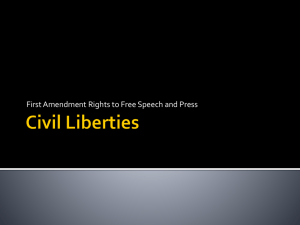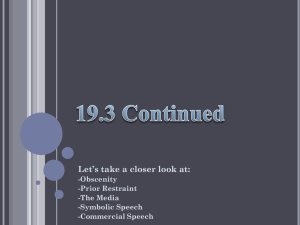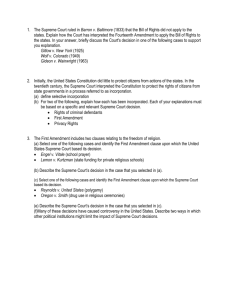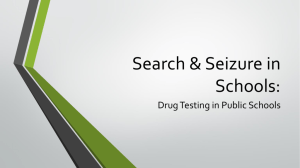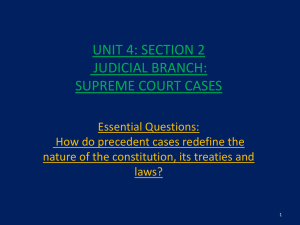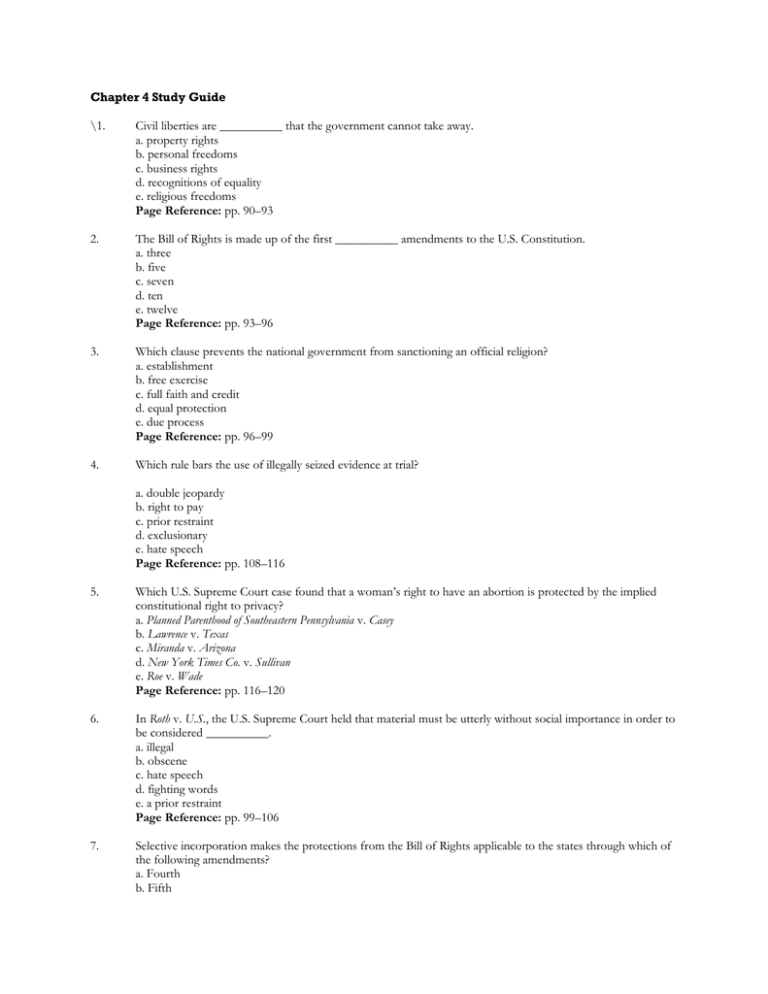
Chapter 4 Study Guide
\1.
Civil liberties are __________ that the government cannot take away.
a. property rights
b. personal freedoms
c. business rights
d. recognitions of equality
e. religious freedoms
Page Reference: pp. 90–93
2.
The Bill of Rights is made up of the first __________ amendments to the U.S. Constitution.
a. three
b. five
c. seven
d. ten
e. twelve
Page Reference: pp. 93–96
3.
Which clause prevents the national government from sanctioning an official religion?
a. establishment
b. free exercise
c. full faith and credit
d. equal protection
e. due process
Page Reference: pp. 96–99
4.
Which rule bars the use of illegally seized evidence at trial?
a. double jeopardy
b. right to pay
c. prior restraint
d. exclusionary
e. hate speech
Page Reference: pp. 108–116
5.
Which U.S. Supreme Court case found that a woman’s right to have an abortion is protected by the implied
constitutional right to privacy?
a. Planned Parenthood of Southeastern Pennsylvania v. Casey
b. Lawrence v. Texas
c. Miranda v. Arizona
d. New York Times Co. v. Sullivan
e. Roe v. Wade
Page Reference: pp. 116–120
6.
In Roth v. U.S., the U.S. Supreme Court held that material must be utterly without social importance in order to
be considered __________.
a. illegal
b. obscene
c. hate speech
d. fighting words
e. a prior restraint
Page Reference: pp. 99–106
7.
Selective incorporation makes the protections from the Bill of Rights applicable to the states through which of
the following amendments?
a. Fourth
b. Fifth
c. Sixth
d. Tenth
e. Fourteenth
Page Reference: pp. 93–96
8.
Article I of the Constitution prohibits which of the following, which make an act punishable as a crime even if
the act was legal when it was committed?
a. writs of habeas corpus
b. bills of attainder
c. ex post facto laws
d. procedural guarantees
e. prior restraints
Page Reference: pp. 93–96
9.
A false written statement is __________; the same statement spoken aloud is __________.
a. defamation, slander
b. slander, libel
c. libel, defamation
d. libel, slander
e. slander, defamation
Page Reference: pp. 99–106
10.
Which amendment protects the right to bear arms?
a. First
b. Second
c. Third
d. Fourth
e. Fifth
Page Reference: pp. 106–108
11.
The Constitution protects against search of an individual’s person, home, or vehicle without __________.
a. due process
b. permission
c. a warrant
d. compensation
e. a good reason
Page Reference: pp. 108–116
12.
What does the Sixth Amendment guarantee to those accused of a crime?
a. assistance of counsel
b. access to law books
c. a jury trial
d. assistance by the press
e. a written indictment
Page Reference: pp. 108–116
13.
Today, the United States is the only western country to use which of the following to punish crime?
a. prison system
b. juvenile justice system
c. Eighth Amendment
d. death penalty
e. corporal punishment
Page Reference: pp. 108–116
14.
What did Abington School District v. Schempp find to be unconstitutional?
a. state-mandated Bible reading
b. forced sterilization
c. segregated education
d. discrimination against homosexuals
e. imprisonment without a trial
Page Reference: pp. 96–99
15.
The free exercise clause guarantees that the national government will not interfere with which of the following?
a. education
b. finance
c. business
d. speech
e. religion
Page Reference: pp. 96–99
16.
Profanity, obscenity, and threats are examples of which of the following?
a. hate speech
b. prior restraints
c. fighting words
d. free speech
e. free exercise
Page Reference: pp. 99–106
17.
According to Table 4.1, How Has Selective Incorporation Made the Bill of Rights Applicable to the States?, which of the
constitutional amendments was the first to be incorporated and applied to the states?
a. Fourth
b. Fifth
c. First
d. Second
e. Eighth
Page Reference: pp. 93–96
18.
Which of the following generally is unconstitutional in school?
a. fighting
b. a weapon
c. free speech
d. prayer
e. punishment
Page Reference: pp. 96–99
19.
According to Justice Blackmun, a woman had which type of right to an abortion in her first trimester?
a. an absolute right
b. no right
c. a qualified right
d. a partial right
e. an arguable right
Page Reference: pp. 116–120
20.
In 2004, the Supreme Court ruled that detainees have a right to which of the following?
a. due process
b. the assistance of counsel
c. equal protection
d. habeas corpus
e. a bill of attainder
Page Reference: pp. 120–122
21.
The doctrine of prior restraint prevents the government from prohibiting speech or publication __________.
a. that is obscene
b. after the fact
c. that is illegal
d. that is critical of the government
e. before the fact
Page Reference: pp. 99–106
22.
In Near v. Minnesota, the Supreme Court further developed which of the following?
a. exclusionary rule
b. due process clause
c. incorporation doctrine
d. free exercise clause
e. equal protection clause
Page Reference: pp. 93–96
23.
Which test examines the constitutionality of religious establishments?
a. Orange
b. Lemon
c. Free Exercise
d. Prior Restraint
e. Due Process
Page Reference: pp. 96–99
24.
Miranda rights include the right to which of the following?
a. a phone call
b. due process
c. a jury trial
d. be free from search and seizure
e. counsel
Page Reference: pp. 108–116
25.
The USA PATRIOT Act enhances the government’s ability to do which of the following?
a. examine private records
b. take personal property
c. imprison citizens without trial
d. indict foreign enemies
e. control public schooling
Page Reference: pp. 120–122
26.
Which Supreme Court case developed the exclusionary rule?
a. Parker v. Gideon
b. New York Times Co. v. Sullivan
c. Mapp v. Ohio
d. Wolf v. Colorado
e. Gideon v. Wainwright
Page Reference: pp. 108–116
27.
The Supreme Court has ruled that states can limit abortions if the regulations do not pose which of the
following?
a. a bar to equal protection
b. a due process violation
c. a prior restraint
d. an undue burden
e. a substantial inconvenience
Page Reference: pp. 116–120
28.
The Supreme Court briefly outlawed which of the following in the 1970s by asserting that it was being imposed
in an arbitrary manner?
a. capital punishment
b. school prayer
c. access to court-appointed counsel
d. symbolic speech protection
e. the exclusionary rule
Page Reference: pp. 108–116
29.
What kind of speech is by its very utterance intended to inflict injury or incite an immediate breach of peace?
a. hate speech
b. symbolic speech
c. political speech
d. fighting words
e. obscenity
Page Reference: pp. 99–106
30.
What type of due process protects citizens from arbitrary or unjust state or federal laws?
a. procedural
b. constitutional
c. substantive
d. individual
e. prospective
Page Reference: pp. 93–96
31.
The Supreme Court has used selective incorporation to __________ the rights of states.
a. protect
b. limit
c. expand
d. define
e. enforce
Page Reference: pp. 93–96
32.
The Sixth Amendment sets out basic requirements for which type of due process?
a. civil
b. substantive
c. criminal
d. procedural
e. constitutional
Page Reference: pp. 108–116
33.
In matters of religion, the free exercise clause protects individuals from which of the following?
a. discrimination
b. persecution
c. governmental intrusion
d. segregation
e. dissenting opinions
Page Reference: pp. 96–99
34.
New York Times Co. v. Sullivan held that there must be proof of which of the following in order to find libel
against a public figure?
a. property loss
b. actual malice
c. an audience
d. a written record
e. actual harm
Page Reference: pp. 99–106
35.
In which case did the Supreme Court first recognize the exclusionary rule, which bars the use of illegally seized
evidence at trial?
a. Weeks v. U.S.
b. Gideon v. Wainwright
c. Furman v. Georgia
d. House v. Bell
e. Griswold v. Connecticut
Page Reference: pp. 108–116
36.
In what year did the Supreme Court first rule that the use of confessions obtained after physical beatings were
unconstitutional?
a. 1906
b. 1976
c. 1946
d. 1936
e. 1956
Page Reference: pp. 108–116
37.
Which Supreme Court case upheld the National Firearms Act, which imposed taxes on some kinds of
weapons?
a. U.S. v. Miller
b. Gideon v. Wainwright
c. Miranda v. Arizona
d. Mapp v. Ohio
e. Griswold v. Connecticut
Page Reference: pp. 106–108
38.
The USA PATRIOT Act expands an exception found in which amendment to allow spying?
a. First
b. Second
c. Fourth
d. Fifth
e. Sixth
Page Reference: pp. 120–122
39.
The “right to remain silent” is a citizen’s protection against which of the following?
a. governmental intrusion
b. search and seizure
c. religious establishment
d. a biased jury
e. self-incrimination
Page Reference: pp. 108–116
40.
If a police officer has a reasonable belief that someone is committing or about to commit a crime, that officer
can stop and frisk the suspect without __________.
a. their consent
b. arresting them
c. a warrant
d. a witness
e. evidence
Page Reference: pp. 108–116
41.
The double jeopardy clause prevents an individual who is acquitted of a crime from which of the following?
a. media coverage
b. being tried again
c. going free
d. asserting innocence
e. seeking the assistance of an attorney
Page Reference: pp. 108–116
42.
Which of the following is an example of procedural due process?
a. the right to bear arms
b. the right to a speedy trial
c. the right to free speech
d. the right to practice religion
e. the right to vote
Page Reference: pp. 108–116
43.
The prohibition on cruel and unusual punishment comes from which of the following?
a. Native American principles
b. French civil law
c. English common law
d. German criminal codes
e. Spanish jurisprudence
Page Reference: pp. 108–116
44.
Which of the following created the right to privacy?
a. the Bill of Rights
b. the Constitution
c. the executive branch
d. the legislature
e. the judiciary
Page Reference: pp. 116–120
45.
In Barron v. Baltimore, the Supreme Court held that the Bill of Rights limits __________, not __________,
action.
a. federal, state
b. state, federal
c. state, local
d. local, state
e. federal, local
Page Reference: pp. 93–96
46.
Shouting profanities in public is an example of __________, which is not protected speech.
a. hate speech
b. fighting words
c. obscenity
d. libel
e. slander
Page Reference: pp. 99–106
47.
In recent years, the Supreme Court has struggled to address __________ on the Internet in a First Amendment
context.
a. slander
b. libel
c. hate speech
d. obscenity
e. fighting words
Page Reference: pp. 99–106
48.
What is the most common form of firearm regulation?
a. gun bans
b. licensing requirements
c. concealed carry restrictions
d. right to carry
e. handgun waiting periods
Page Reference: pp. 106–108
49.
Convicted criminals whose sentences increase during their prison term due to a change in the law have been
illegally subjected to what kind of law?
a. cruel and unusual
b. habeas corpus
c. ex post facto
d. bill of attainder
e. writ of certiorari
Page Reference: pp. 108–116
50.
Which of the following is responsible for determining whether enough evidence exists to support a conviction
against a criminal defendant?
a. trial court
b. defense attorney
c. prosecutor
d. legislature
e. jury
Page Reference: pp. 108–116
51.
Substantive due process created a standard whereby the states had a legal burden to prove that their laws were
which of the following?
a. a valid exercise of power
b. fairly applied to all citizens
c. consistent with the First Amendment
d. consistent with federal regulations
e. similar to one another
Page Reference: pp. 93–96
52.
What do proponents of the Guantanamo Bay detention facility call its prisoners?
a. war criminals
b. enemy combatants
c. prisoners of war
d. foreign aggressors
e. enemy troops
Page Reference: pp. 120–122
53.
Although the speech in question was suppressed, the Court in Gitlow v. New York held that not all forms of
__________ can be limited.
a. hate speech
b. symbolic speech
c. political speech
d. fighting words
e. obscenity
Page Reference: pp. 93–96
54.
Which of the following best explains the rationale for the selective incorporation of freedom of assembly?
a. It is included in the Bill of Rights.
b. The framers intended for the state and federal governments to respect this right.
c. It is a fundamental freedom essential to order, liberty, and justice.
d. The text of the First Amendment specifically references the states.
e. It is one of the implicit rights reserved to the people by the Ninth Amendment.
Page Reference: pp. 93–96
55.
Which of the following rights has the Supreme Court found to be one of the penumbra of unstated liberties
linked to explicitly stated rights?
a. right to marry
b. right to travel
c. right to vote
d. right to privacy
e. right to have a family
Page Reference: pp. 116–120
56.
Which of the following could pass muster and not be considered obscenity under the Roth test?
a. child pornography
b. nude images
c. film
d. hardcore pornography
e. profane language
Page Reference: pp. 99–106
57.
The Alien and Sedition Acts are an example of what kind of law?
a. violation of free speech
b. prior restraint
c. content-based
d. civil
e. criminal
Page Reference: pp. 99–106
58.
During World War I, the Supreme Court upheld the Espionage Act by ruling that Congress has a right to
restrict speech that __________.
a. is critical of the government
b. is a prior restraint
c. creates a clear and present danger
d. qualifies as hate speech
e. is symbolic but obscene
Page Reference: pp. 99–106
59.
The Military Commission Act of 2006 allows the government to jail detainees without an opportunity to file
which of the following?
a. an appeal
b. a writ of habeas corpus
c. a bill of attainder
d. a motion for summary judgment
e. a jury demand
Page Reference: pp. 120–122
60.
Which of the following emanates from a “penumbra” and not an explicitly stated constitutional right?
a. the right of parents to direct the education of their children
b. the free speech rights of children at school
c. the prohibition on school prayer in public schools
d. the right of religious schools to be free from state taxes
e. the right of children to have a lawyer at juvenile court proceedings
Page Reference: pp. 116–120
Short Answer Questions
91.
Discuss the development of hate speech as an unprotected speech form.
Page Reference: pp. 99–106
92.
Discuss why selective incorporation is consistent with larger themes in federalism.
Page Reference: pp. 93–96
93.
How does the Lemon test examine the constitutionality of religious establishment issues?
Page Reference: pp. 96–99
94.
What are the historical roots of the right to bear arms?
Page Reference: pp. 106–108

